
USS Culgoa (AF-3) was a refrigerated supply ship in the United States Navy.
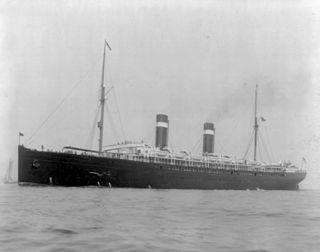
SS St. Louis was a passenger liner built in 1894 and sponsored by the wife of U.S. President Grover Cleveland. She entered merchant service in 1895, operating between New York and Southampton, England. St. Louis was registered in the United States and owned by the International Navigation Company of New York City. She was acquired by the U.S. Navy during both the Spanish–American War and World War I. After the ship reverted to its original name in 1919, she caught fire and was scrapped in Genoa in 1924.
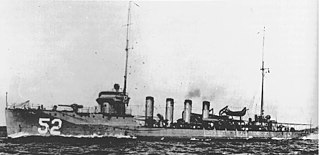
USS Nicholson was an O'Brien-class destroyer built for the United States Navy before the American entry into World War I. The ship was the second U.S. Navy vessel named in honor of five members of the Nicholson family who rendered distinguished service in the American Revolutionary War, the War of 1812, and the American Civil War: brothers James, Samuel, and John Nicholson; William Nicholson, son of John; and James W. Nicholson, grandson of Samuel.

USS Comfort (AH-3) was a hospital ship for the United States Navy in World War I. She was the sister ship of USS Mercy (AH-4) but the two ships were not of a ship class. Comfort was known as SS Havana in passenger service for the Ward Line, and as USAT Havana in United States Army service before her Navy service. Her name was restored to Havana in 1927, and she was renamed SS Yucatán in 1935, and SS Agwileon in 1941. In World War II, she was known as USAT Agwileon and USAHS Shamrock in service for the United States Army.
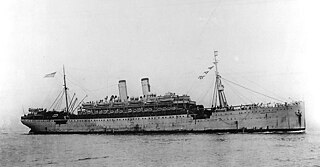
USS Pocahontas (SP-3044) was a transport ship for the United States Navy during World War I. She was originally SS Prinzess Irene, a Barbarossa-class ocean liner built in 1899 by AG Vulcan Stettin of Stettin, Germany, for the North German Lloyd line.

SS Kronprinzessin Cecilie was an ocean liner built in Stettin, Germany in 1906 for North German Lloyd that had the largest steam reciprocating machinery ever fitted in a ship. The last of four ships of the Kaiser class, she was also the last German ship to have been built with four funnels. She was engaged in transatlantic service between her home port of Bremen and New York until the outbreak of World War I.

SS Saale was an ocean liner for North German Lloyd in the late 19th century, which was severely damaged in the 1900 Hoboken Docks Fire. On 30 June 1900, Saale was moored at the North German Lloyd piers in Hoboken, New Jersey, preparing to depart on a transatlantic crossing when some cotton on a nearby pier caught on fire and spread to the ship. Saale and several other ships were soon engulfed in flames; 99 passengers and crew on Saale were killed in the fire and subsequent sinking.

USS DeKalb (ID-3010) was the German mail ship Prinz Eitel Friedrich that served during the early part of the First World War as an auxiliary cruiser (Hilfkreuzer) in the Imperial German Navy and later after the US entry into the war, as a US Navy troop ship. Post war she returned to civilian service as the US transatlantic liner SS Mount Clay.

USS Celtic (AF-2) was a Celtic-class stores ship acquired by the U.S. Navy for use in the Spanish–American War. She served again during World War I in the dangerous North Atlantic Ocean, delivering general goods and ammunition to American Expeditionary Force troops in Europe.

SS Scharnhorst was a German ocean liner and mail ship launched in 1904.

SS Arabic, originally built as Berlin, was a passenger steamship launched on 7 November 1908 which was built by the AG Weser shipbuilding company in Germany. Her gross register tonnage was advertised at 16,786 tons. She made her maiden voyage on 1 May 1909 from New York to Genoa and Bremerhaven. In September 1914 she became an auxiliary cruiser with the Imperial German Navy as a minelayer.
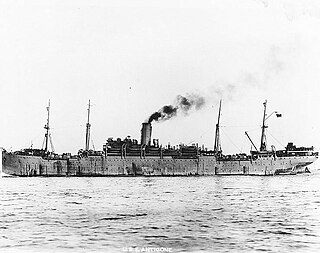
USS Antigone (ID-3007) was a transport for the United States Navy during World War I, and the first ship of that name for the US Navy. She was originally Neckar for Norddeutscher Lloyd from her 1900 launch until seized by the US in 1917. After her war service she was Potomac for United States Lines.
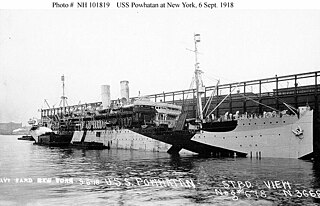
USS Powhatan (ID–3013) was a transport ship for the United States Navy during World War I. She was originally Hamburg, a Barbarossa-class ocean liner built in 1899 by AG Vulkan of Stettin, Germany, for the Hamburg America Line. At the outset of World War I the ship was interned by the United States.

USS Edgar F. Luckenbach (ID-4597) was a cargo ship and troop transport that served in the United States Navy from 1918 to 1919.
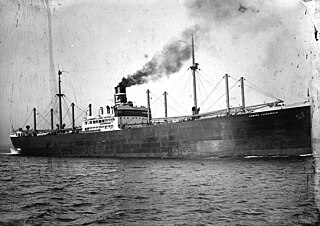
SS Edward Luckenbach was the first of five new cargo ships to be built for the Luckenbach Steamship Company by Fore River Shipbuilding Corporation. The ship was launched in September 1916, delivered in November and briefly operated as such before being requisitioned for World War I service. The ship was one of the cargo vessels in the first large convoy transporting U.S. Army forces to France. After that convoy the ship served as a U.S. Army Chartered Transport (USACT) until converted by the Army to a troop ship and turned over to the Navy a few months before the war's end. The Navy commissioned the ship as USS Edward Luckenbach assigning the miscellaneous identification number ID-1662 in August 1918. The transport made one wartime voyage with continued voyages returning the Army to the U.S. until August 1919.

USS F. J. Luckenbach (ID-2160) was a cargo ship and troop transport that served in the United States Navy from 1918 to 1919. SS F. J. Luckenbach was built as a commercial cargo ship at Quincy, Massachusetts, by Fore River Shipbuilding Corporation for Luckenbach Steamship Company of New York City. Launched on 15 September 1917, she was delivered to Luckenbach on 28 November 1917. She then came under the control of the United States Shipping Board. The Shipping Board transferred her to the U.S. Navy for World War I service on 9 January 1918. Assigned Identification Number 2160, she was commissioned the same day as USS F. J. Luckenbach.

USS Julia Luckenbach (ID-2407) was a cargo ship and troop transport that served in the United States Navy from 1918 to 1919.

USS K. I. Luckenbach (ID-2291) was a cargo ship and troop transport that served in the United States Navy from 1918 to 1919.
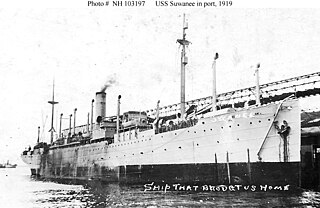
USS Suwanee (ID-1320) was a United States Navy transport in commission in 1919. She was the second ship to carry her name.

SS Tivives was a United Fruit Company passenger and refrigerated fruit cargo ship built 1911 by Workman, Clark & Company, Ltd. in Belfast. The ship was launched 1 August 1911 as Peralta but renamed before completion. As a foreign built vessel operating for a company in the United States the ship was British flagged. With outbreak of war in Europe in 1914 the ship, as did all British registered company ships, changed flag to the United States. Between 5 July 1918 and 25 April 1919 the ship was chartered and commissioned by the United States Navy for operation as USS Tivives





















